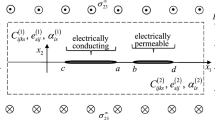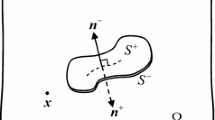Abstract
The behavior of two parallel non-symmetric cracks in piezoelectric materials subjected to the anti-plane shear loading was studied by the Schmidt method for the permeable crack electric boundary conditions. Through the Fourier transform, the present problem can be solved with two pairs of dual integral equations in which the unknown variables are the jumps of displacements across crack surfaces. To solve the dual integral equations, the jumps of displacements across crack surfaces were directly expanded in a series of Jacobi polynomials. Finally, the relations between electric displacement intensity factors and stress intensity factors at crack tips can be obtained. Numerical examples are provided to show the effect of the distance between two cracks upon stress and electric displacement intensity factors at crack tips. Contrary to the impermeable crack surface condition solution, it is found that electric displacement intensity factors for the permeable crack surface conditions are much smaller than those for the impermeable crack surface conditions. At the same time, it can be found that the crack shielding effect is also present in the piezoelectric materials.
Similar content being viewed by others
References
Beom H G, Atluri S N. Near-tip fields and intensity factors for interfacial cracks in dissimilar anisotropic piezoelectric media[J]. International Journal of Fracture, 1996, 75(2):163–183.
Gao H J, Zhang T Y, Tong P. Local and global energy rates for an elastically yielded crack in piezoelectric ceramics[J]. Journal of Mechanics and Physics of Solids, 1997, 45(2):491–510.
Han X L, Wang Tzuchiang. Interacting multiple cracks in piezoelectric materials[J]. International Journal of Solids and Structures, 1999, 36(27):4183–4202.
Yu S W, Chen Z T. Transient response of a cracked infinite piezoelectric strip under anti-plane impact[J]. Fatigue of Engineering Materials and Structures, 1998, 21(3):1381–1388.
Zhang T Y, Hack J E. Mode-III cracks in piezoelectric materials[J]. Journal of Applied Physics, 1992, 71(4):5865–5870.
Sih G C, Zuo J Z. Energy density formulation and interpretation of cracking behavior for piezoelectric ceramics[J]. Theoretical and Applied Fracture Mechanics, 2000, 34(2):123–141.
Deeg W E F. The analysis of dislocation, crack and inclusion problems in piezoelectric solids[D]. Ph D Dissertation, Stanford University, 1980.
Pak Y E. Crack extension force in a piezoelectric material[J]. Journal of Applied Mechanics, 1990, 57(3):647–653.
Han J J, Chen Y H. Multiple parallel cracks interaction problem in piezoelectric ceramics[J]. International Journal of Solids and Structures, 1999, 36(6):3375–3390.
Parton V S. Fracture mechanics of piezoelectric materials[J]. ACTA Astronautra, 1976, 3(4):671–683.
Hao T H, Shen Z Y. A new electric boundary condition of electric fracture mechanics and its applications[J]. Engineering Fracture Mechanics, 1994, 47(6):793–802.
Soh A K, Fang D N, Lee K L. Analysis of a bi-piezoelectric ceramic layer with an interfacial crack subjected to anti-plane shear and in-plane electric loading[J]. European Journal of Mechanics-A/Solids, 2000, 19(6):961–977.
Zhou Z G, Wang B. The behavior of two parallel symmetry permeable interface cracks in a piezoelectric layer bonded to two half piezoelectric materials planes[J]. International Journal of Solids and Structures, 2002, 39(17):4485–4500.
Zhou Zhengong, Wang Biao. The behavior of two parallel symmetric permeable cracks in piezoelectric materials[J]. Applied Mathematics and Mechanics (English Edition), 2002, 23(12):1357–1366.
Sun Jianliang, Zhou Zhengong, Wang Biao. Dynamic behavior of two unequal parallel permeable interface cracks in a piezoelectric layer bonded to two half piezoelectric materials planes[J]. Applied Mathematics and Mechanics (English Edition), 2005, 26(2):160–170.
Sun J L, Zhou Z G, Wang B. Dynamic behavior of unequal parallel permeable interface multicracks in a piezoelectric layer bonded to two piezoelectric materials half planes[J]. European Journal of Mechanics-A/Solids, 2004, 23(6):993–1005.
Morse P M, Feshbach H. Methods of theoretical physics[M]. Vol 1. New York: McGraw-Hill, 1958, 828–930.
Gradshteyn I S, Ryzhik I M. Table of integral, series and products[M]. New York: Academic Press, 1980, 1035–1037.
Erdelyi A. Tables of integral transforms[M]. Vol 1. New York: McGraw-Hill, 1954, 34–89.
Zhou Zhengong, Wang Biao. The dynamic behavior of two parallel symmetry cracks in magneto-electro-elastic composites under harmonic anti-plane shear waves[J]. Applied Mathematics and Mechanics (English Edition), 2006, 27(5):583–591.
Ratwani M, Gupta G D. Interaction between parallel cracks in layered composites[J]. International Journal of Solids and Structures, 1974, 10(7):701–708.
Author information
Authors and Affiliations
Corresponding author
Additional information
Contributed by WANG Biao
Project supported by the National Natural Science Foundation of China (Nos.10572043 and 10572155) and the Natural Science Foundation for Excellent Young Investigators of Heilongjiang Province (No.JC04-08)
Rights and permissions
About this article
Cite this article
Zhou, Zg., Wang, B. Basic solution of two parallel non-symmetric permeable cracks in piezoelectric materials. Appl Math Mech 28, 417–428 (2007). https://doi.org/10.1007/s10483-007-0401-z
Received:
Revised:
Issue Date:
DOI: https://doi.org/10.1007/s10483-007-0401-z




